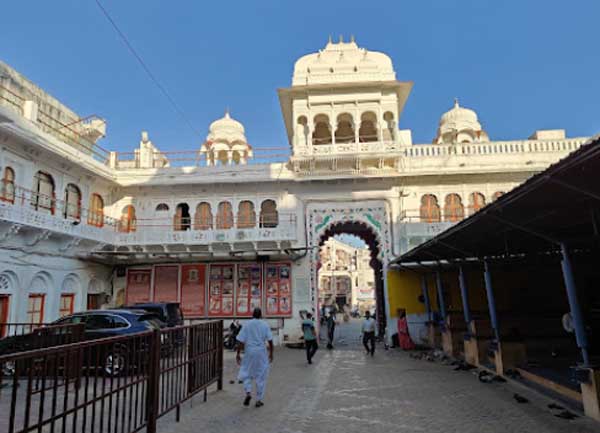Kankroli Dwarkadhish Mandir, situated in the picturesque town of Kankroli, Rajasthan, holds a rich history that intertwines with the tumultuous times of the Mughal period. Established in 1719 CE by Goswamai Shri Girdhariji Maharaj, the Kankroli Dwarkadhish temple is a testament to resilience and devotion.
Kankroli Dwarkadhish Mandir History Story
During the Mughal era, temples faced frequent invasions,
vandalism, and arson, making the deities vulnerable to destruction. Shri
Dwarkadhishji's idol, originally located in Gokul, was exposed to such dangers.
Fearing for the safety of the deity, Goswami Shri Girdharji Maharaja fled to
Ahmedabad, Gujarat, taking the idol with him. However, the apprehension
persisted, prompting the Maharana of Udaipur, Shri Rajsingh ji, to request Shri
Girdhar Maharaj to bring the idol to Kankaroli.
In Vikram Samvat 1726, the idol found its new home in a
village called Asotiya, near Kankroli. Subsequently, the temple on the bank of
Rajsamand was completed, and the deity's idol was enshrined there. The hill on
which the temple stands was named Girdhar Garh in honor of Goswami Shri
Girdharji, the guardian of the deity during those perilous times. Since then,
Shri Dwarkadheeshji has been revered at this sacred site.
The temple follows the tenets of Pushtimarg, a devotional path established by his Holiness Ballabhacharyaji. Daily services are conducted with utmost devotion, adhering to the traditions of Pushtimarg.
Architecturally, the temple reflects the Haveli style,
showcasing intricate craftsmanship and design. Positioned on a hilltop, the
temple provides a breathtaking panoramic view of the surroundings, with the
Rajsamand Dam's vast expanse nearby. Its elevated location makes the temple
visible from a considerable distance, adding to its allure.
Throughout the year, the temple hosts festivals in
accordance with Pushtimarg traditions. In the month of Shravan, swing festival
is held, creating a festive atmosphere and attracting devotees from far and
wide to partake in the joyous celebrations. Kankroli Dwarkadhish Mandir stands
not only as a religious landmark but also as a symbol of resilience and
devotion in the face of historical challenges.
Kankroli Dwarkadhish Mandir Festivals
The Kankroli Dwarkadhish temple, following the traditions
of Pushtimarg, celebrates a series of festivals throughout the year. These
festivals are not only religious observances but also vibrant and joyous
occasions that bring the community together in spiritual celebration. Each
festival has its own unique significance, rituals, and cultural practices.
Here's an expansion on some of the mentioned festivals:
Swing Festival in Shravan: Celebrated during the auspicious
month of Shravan, devotees swing the deity in beautifully decorated swings,
symbolizing the playful and joyous nature of Lord Krishna.
Janmashtami: This festival commemorates the birth of Lord
Krishna. Devotees observe fasts, engage in devotional singing and dancing, and
participate in various cultural events to celebrate the divine birth.
Nanda Mahotsava: Dedicated to Lord Krishna's foster father Nanda, this festival honors the significant role of parental figures in the life of Lord Krishna. Devotees express their gratitude through prayers and festivities.
Diwali: The festival of lights, Diwali, is celebrated
with enthusiasm. Devotees illuminate the temple and surrounding areas with
diyas (oil lamps) to symbolize the triumph of light over darkness.
Annakuta: Devotees offer a mountain of food to the deity in
a ritual known as Annakuta, symbolizing gratitude for the bounties of nature
and seeking the blessings of Lord Krishna.
Patotsava: This is a celebration of the consecration
anniversary of the temple deity. Special rituals, prayers, and cultural
programs mark this occasion.
Phag in Phalgun Month: Celebrated during the Phalgun month,
devotees engage in the joyful and colorful festivities of Holi, signifying the
triumph of good over evil.
Holi: The festival of colors is celebrated with enthusiasm
and fervor. Devotees joyfully throw colored powders, dance, and sing in
celebration of the divine play of Lord Krishna.
Dolotsava: Also known as Holi, Dolotsava involves the
swinging of the deity in a decorated palanquin, accompanied by music, dance,
and festive processions.
Ramnavami: This festival marks the birth of Lord Rama, an
avatar of Lord Vishnu. Devotees observe fasts, read the Ramayana, and
participate in prayers to honor Lord Rama.
Akshaya Tritiya: Considered an auspicious day, Akshaya Tritiya in Vaishakh is celebrated with special prayers and offerings. Devotees believe that any
auspicious activity or venture started on this day will be blessed with
success.
Ratha Yatras: Various Ratha Yatras involve the ceremonial
processions of deities in chariots. Devotees pull the chariots through the
streets, accompanied by chanting and music, symbolizing the journey of the
divine.
These festivals not only uphold the rich cultural and
religious traditions of Pushtimarg but also serve as occasions for spiritual
reflection, community bonding, and the expression of devotion to the divine.

